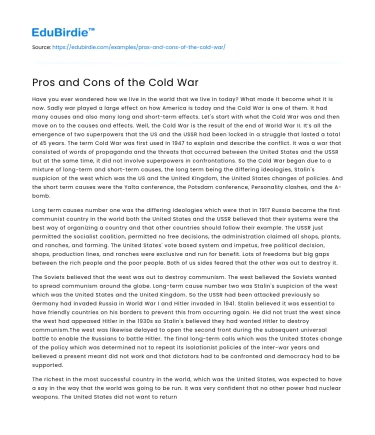Introduction
The Cold War, a prolonged period of geopolitical tension between the United States and the Soviet Union, was an era marked by ideological conflicts, technological advancements, and profound global impact. Spanning from the end of World War II to the dissolution of the Soviet Union in 1991, this period shaped the modern world in numerous ways. While the Cold War never escalated into a full-scale direct military conflict, its implications were far-reaching and multifaceted. This essay aims to critically analyze the pros and cons of the Cold War by examining its impact on global politics, technological innovation, and international relations. By delving into specific examples and addressing counter-arguments, this discourse seeks to provide a balanced perspective on the legacy of the Cold War.
Geopolitical Implications
The geopolitical landscape of the Cold War era was characterized by a bipolar world order, with the United States and the Soviet Union vying for global supremacy. On the one hand, this rivalry led to the formation of strategic alliances such as NATO and the Warsaw Pact, which provided a framework for collective security and deterred direct military confrontations. According to historian John Lewis Gaddis, "The Cold War was a time of paradoxes: peace maintained through the threat of war, alliances formed against a common enemy." This period also saw the decolonization of Africa and Asia, as the superpowers sought to expand their ideological influence by supporting independence movements.
Save your time!
We can take care of your essay
- Proper editing and formatting
- Free revision, title page, and bibliography
- Flexible prices and money-back guarantee
However, the geopolitical rivalry also had its drawbacks. The Cold War fueled numerous proxy wars, such as the Korean and Vietnam Wars, which resulted in significant loss of life and destabilized regions. Moreover, the constant threat of nuclear annihilation, epitomized by the Cuban Missile Crisis, created a pervasive atmosphere of fear and uncertainty. The arms race diverted resources from social and economic development, leading to widespread poverty and underdevelopment in many parts of the world. Despite these challenges, the Cold War inadvertently promoted international diplomacy, as both superpowers engaged in negotiations to prevent catastrophic conflicts.
Technological Advancements
One of the most significant outcomes of the Cold War was the unprecedented technological advancements that emerged from the competition between the United States and the Soviet Union. The space race, for instance, culminated in the historic Apollo 11 moon landing, a testament to human ingenuity and scientific progress. As physicist Neil deGrasse Tyson notes, "The Cold War was a major driver of technological innovation, as both superpowers competed to demonstrate their superiority."
These advancements extended beyond space exploration. The Cold War spurred developments in computer technology, telecommunications, and military hardware, many of which have since been adapted for civilian use. Yet, the race for technological dominance was not without its costs. The emphasis on military research and development often overshadowed other scientific endeavors, leading to a narrow focus on defense-related technologies. Furthermore, the environmental impact of nuclear testing and space exploration raised ethical concerns about the long-term sustainability of such pursuits. Despite these issues, the Cold War era laid the foundation for the technological landscape of the 21st century.
Impact on International Relations
The Cold War's impact on international relations was profound, shaping the dynamics of diplomacy and conflict resolution for decades. The doctrine of mutually assured destruction (MAD) prevented direct military confrontation between the superpowers, emphasizing the importance of negotiation and diplomacy. The establishment of the United Nations and various arms control treaties, such as the Strategic Arms Limitation Talks (SALT), exemplified efforts to maintain global stability.
Nevertheless, the Cold War also entrenched ideological divisions, often reducing complex international issues to a binary struggle between capitalism and communism. This oversimplification hindered the resolution of regional conflicts and perpetuated global inequalities. For instance, the U.S. support for authoritarian regimes in Latin America and Africa, justified as a countermeasure against communism, led to long-lasting political and social repercussions. Despite these challenges, the end of the Cold War marked a shift towards a more multipolar world order, opening opportunities for cooperation and reconciliation among former adversaries.
Conclusion
In conclusion, the Cold War was a period of significant geopolitical, technological, and international transformation. While it brought about strategic alliances and technological advancements, it also engendered proxy wars, ideological divisions, and ethical dilemmas. By critically examining the pros and cons of the Cold War, this essay underscores the complexity of its legacy. The lessons learned from this era continue to inform contemporary global politics, emphasizing the importance of diplomacy, cooperation, and innovation. As the world navigates new challenges, the Cold War serves as a reminder of the delicate balance between conflict and collaboration in shaping the future.






 Stuck on your essay?
Stuck on your essay?

